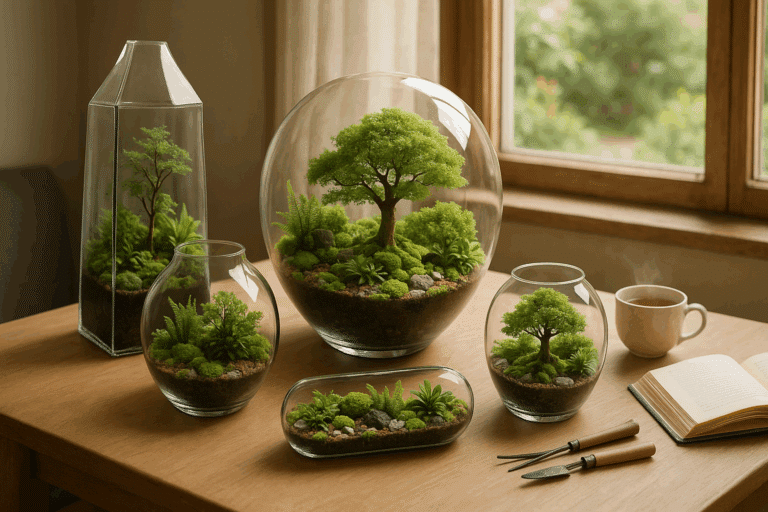Our upcoming post unveils an innovative way of transforming any corner of your house into a thriving indoor garden. Say hello to “Grow Anywhere, Anytime: Transform Your Space with an Indoor Garden on a Cart”. This ingenious method is designed to help plant lovers overcome space constraints, while enjoying fresh produce throughout the year. 🌿

This post will explore various aspects of creating an indoor garden on a cart. We will be discussing different types of suitable plants, the basic essentials for setting up your garden cart, and the best methods to maintain it. The best part? The mobility of the cart allows you to move your garden according to the needs of your plants, ensuring they always get the right amount of sunlight.
Whether you’re an urban dweller with limited outdoor space or simply someone looking to add a touch of green to your interior decor, this comprehensive guide is sure to fuel your interest. So prepare to harness the joy of gardening, regardless of space, season, or location. Let’s dive into the world of indoor garden carts and embrace the potential for indoor gardening magic. 🌱🌼
The Concept: An Indoor Garden on a Cart
Indoor gardening is no longer limited to traditional planters and pots; it’s taking a new, more flexible form: an indoor garden on a cart. This innovative idea not only gives you the freedom to move your garden around according to your needs but also presents an aesthetic appeal to your indoor space.
An indoor garden on a cart is simply a mobile garden, often housed on a multi-tiered, wheeled cart. The cart can host a variety of plants, from herbs to small vegetables and decorative plants. The key elements of this type of indoor garden include the cart’s design, the type of plants, and the use of appropriate plant-growing technology.
The Cart
The cart is the foundation of this indoor gardening concept. It should be sturdy, with multiple levels to maximize space. Some carts come with built-in LED lights for each shelf, providing the necessary light spectrum for the plants’ growth. Others might require the addition of grow lights.
Choosing a cart with wheels provides the advantage of mobility. You can move your indoor garden around to ensure that the plants get enough light, or you could simply change its location for aesthetic reasons or to facilitate maintenance tasks such as watering or pruning.
Creating Your Indoor Garden: Steps and Considerations
Setting up your indoor garden on a cart requires careful planning and execution. Here’s a step-by-step guide:
Step 1: Choose the Right Cart
Consider factors like size, material, design, and functionality. Carts made of metal or treated wood are often preferred for their durability. Some carts come with built-in features like LED lights or self-watering systems, which can be beneficial for plant growth.
Step 2: Select Your Plants
When choosing plants, consider their light and water requirements, growth rate, and compatibility with other plants. It’s advisable to group plants with similar needs together. Some popular choices for indoor cart gardens include herbs like basil and parsley, leafy greens like lettuce, and decorative plants like succulents or ferns.
Step 3: Set Up the Lighting
If your cart doesn’t come with built-in LED lights, you’ll need to install your own. Make sure to choose lights that provide the right spectrum for plant growth. LED lights are often preferred for their energy efficiency and longevity.
Step 4: Prepare the Containers
Choose containers or pots that fit comfortably on your cart shelves while allowing adequate room for plant roots to grow. Containers should have drainage holes to prevent waterlogging, and trays underneath to catch excess water and protect the cart’s surface. You may also want to use lightweight materials like plastic or biodegradable pots to make rearranging easier. For a more coordinated aesthetic, consider using pots in matching colors or materials.
Step 5: Add Soil and Plant
Use high-quality potting soil suitable for the types of plants you’re growing. Avoid using garden soil, which can compact and hinder drainage indoors. Once the soil is in place, carefully transplant your chosen plants into their containers. Be sure to gently loosen their roots before planting to encourage healthier growth. Water the plants lightly after planting to help them settle in.
Step 6: Arrange and Decorate
Now it’s time to arrange your plants on the cart. Place taller or trailing plants on the top or bottom shelves, depending on how you want them to cascade or be highlighted. Group similar plants together for easier care routines and a tidy look. You can also personalize the cart with decorative touches like plant labels, stones, or fairy lights to enhance visual appeal.
Step 7: Monitor and Adjust
The first few weeks after setting up your garden are critical. Observe how your plants respond to their new environment. Are they getting enough light? Do they show signs of over- or under-watering? Adjust lighting schedules, watering frequency, and plant placement as needed. Keeping a simple plant journal can help track progress and changes over time.
Step 8: Seasonal Considerations and Rotation
As seasons change, so do indoor conditions. Even indoors, shifts in humidity, daylight hours, and room temperature can affect your plants. During winter, you may need to increase supplemental lighting or reduce watering frequency due to slower plant metabolism. In the summer, monitor for heat stress and increase watering if necessary. Rotate your plants regularly to ensure even light distribution and prevent them from leaning toward one side.
Having a flexible, movable garden cart allows you to respond to seasonal changes easily. You can shift the entire garden closer to a sunny window in winter or move it away from harsh sunlight during summer. This adaptability is one of the cart garden’s greatest advantages for year-round success.
Managing Your Indoor Garden on a Cart
Maintaining an indoor garden on a cart involves regular watering, monitoring plant health, and managing light exposure. It’s also essential to periodically check and maintain the cart itself to ensure its durability and functionality.
Watering and Plant Care
Regular watering is crucial for the health of your indoor garden. However, the watering needs can vary based on the type of plants, their stage of growth, and the ambient conditions. Self-watering systems can automate this process and help maintain optimal moisture levels.
Light Management
Effective light management is crucial for indoor gardening. Ensure your plants receive adequate light without being exposed to too much direct sunlight. The mobility of the garden cart can be beneficial in this regard, as it allows you to adjust the location of your garden based on light conditions.
Benefits of an Indoor Garden on a Cart
An indoor garden on a cart offers numerous benefits that go beyond just beautifying your home. It provides a unique and practical way to incorporate greenery into your indoor spaces, enhancing aesthetics while contributing to better air quality. These mobile gardens are ideal for apartments, offices, classrooms, and homes where outdoor space is limited or nonexistent. With the addition of a rolling cart, your indoor garden becomes a dynamic feature that adapts to your lifestyle, needs, and space constraints.
Space Optimization
A garden on a cart optimizes space usage by accommodating plants on multiple tiers or shelves. Unlike traditional plant setups, which may be spread out across window sills or floor space, a cart-based garden utilizes vertical space efficiently. Some carts offer three or four tiers, allowing you to grow a variety of plants—from leafy greens and herbs to flowering varieties and decorative houseplants—all in one compact footprint. This vertical layering not only maximizes space but also allows for better plant grouping based on light or water needs.
This solution is especially beneficial for urban dwellers or those living in small apartments, where even a square meter of space is valuable. With careful arrangement, even a tiny studio apartment can host a thriving indoor garden without compromising on comfort or functionality.
Mobility and Flexibility
The mobility of a garden cart provides exceptional flexibility in terms of layout and light management. You can easily move your garden around your home to take advantage of natural sunlight during different times of the day. For example, you might roll your cart next to a bright east-facing window in the morning and shift it to another room in the afternoon to capture maximum light exposure.
Beyond light management, mobility also allows you to adapt your garden’s location based on seasonal changes. During colder months, you can bring your cart closer to heat sources or grow lights, while in spring and summer, it can sit near an open window or balcony door. The flexibility to move your garden with ease also makes cleaning easier, as you can roll the cart aside to vacuum or mop the floors underneath.
Improved Air Quality and Aesthetics
Indoor plants are known to improve air quality by absorbing carbon dioxide and releasing oxygen, but their benefits don’t stop there. Many plants also filter common indoor toxins like benzene, formaldehyde, and trichloroethylene, creating a cleaner and healthier living environment. The more diverse your garden, the more variety of pollutants it can help neutralize.

In terms of aesthetics, an indoor garden brings a natural touch to modern interiors, breaking up the monotony of man-made materials and sharp angles with soft, organic shapes and soothing greenery. Whether your style is minimalist, rustic, or eclectic, there’s a way to style your garden cart to match. Adding trailing vines, colorful pots, or LED fairy lights can elevate the visual appeal of your mobile garden and turn it into a statement piece.
Mental Wellness and Accessibility
An often-overlooked benefit of an indoor garden on a cart is its contribution to mental wellness. Tending to plants has been shown to reduce stress, improve mood, and even enhance focus and productivity. The act of watering, pruning, or simply observing plant growth can be meditative and grounding—especially valuable in high-stress urban environments.
The cart’s design also offers better accessibility for people with limited mobility. Because the cart can be moved and adjusted in height, gardeners who may have difficulty bending or reaching can position the cart at a comfortable level. This makes indoor gardening more inclusive and enjoyable for people of all ages and abilities.
Customization and Multi-Purpose Use
Another advantage is the ability to customize your cart setup. You can include built-in lighting on upper tiers, hang mini grow lights from the shelves, or install small trays for organizing tools, seeds, and nutrients. Some people even convert one tier of their garden cart into a composting station or a seed-starting shelf with heat mats and humidity domes.
Additionally, your indoor garden cart can serve dual purposes. It can function as a mobile herb station in the kitchen, a green divider between living spaces, or a conversation piece in a living room or office corner.
Conclusion
In conclusion, the concept of “Grow Anywhere, Anytime: Transform Your Space with an Indoor Garden on a Cart” is a revolutionary approach to urban gardening. It allows individuals to harness their green thumb, irrespective of space constraints. By employing this strategy, you are not only maximizing your living space but also contributing positively to the environment. The indoor garden on a cart offers an unprecedented level of flexibility, making it possible to grow your favorite plants year-round, even in the most compact spaces.
It’s more than just a hobby; it’s a sustainable way to ensure a fresh supply of homegrown produce, right at your fingertips. This innovative method is also a testament to human creativity, proving that with a little ingenuity, even the most challenging situations can be turned into opportunities.
To sum up, the indoor garden on a cart is a game-changer, effectively blurring the lines between urban living and the serenity of nature. It’s a green solution that’s adaptable, convenient, and eco-friendly. Start your journey to sustainable living by transforming your space into an indoor garden on a cart. Not only will you reap the benefits of fresh produce, but also experience the therapeutic effects of gardening. Happy planting!



